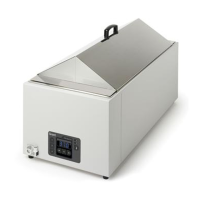Unstirred water bath SAP, JBA, JBN Service Manual (Version 1.0) September 2013
31667 Page 17 of 23
4.2.2 Useful values for fault finding
68-80Ω (120V)
252-294Ω (230V)
Heater 2 litre shallow & 5 litre models
39-45Ω (120V)
144-168Ω (230V)
17-20Ω (120V)
63-74Ω (230V)
Heater 18 litre & 26 litre models
13-15Ω (120V)
36-42Ω (230V)
10.5-12.5Ω (120V)
28-32Ω (230V)
See 5 litre and 12 litre values above
approx 1070 to 1120Ω at room temperature
(18-31°C)
4.3 Final Tests – Electrical Safety
After any repair, the unit should be electrically tested to ensure that it is safe.
WARNING: The following process should always be carried out after any repair to ensure
safety. If the bath fails either test below then it must be repaired and successfully retested
before being put back into operation.
4.3.1 Check Earth Connection
Using an Ohm meter or, preferably, a specialised earth bond checker (max 25A test current),
verify that the resistance between the earth pin of the equipment inlet and the exposed
metalwork is less than 0.1Ohm. In the case of the painted panels it is acceptable to make the
contact with the screw heads.
4.3.2 Check Insulation
Use a high voltage tester set to 2000VDC. Connect the live and neutral terminals of the bath
together and apply the test voltage between them and the earth contact of the bath. The test
voltage should be raised to its full value in less than 2 seconds, held for 2 seconds and then
reduced back to zero.
No breakdown or repeated flashover shall occur. Corona effects and similar phenomena are
disregarded
4.3.3 Routine testing
If routine tests are to be made, we recommend a test of the integrity of the protective
earth conductor and an insulation test at 500V DC. Routine flash tests are not
recommended for any electrical equipment, because repeated high voltage tests degrade
insulation materials.

